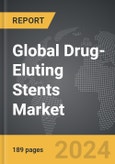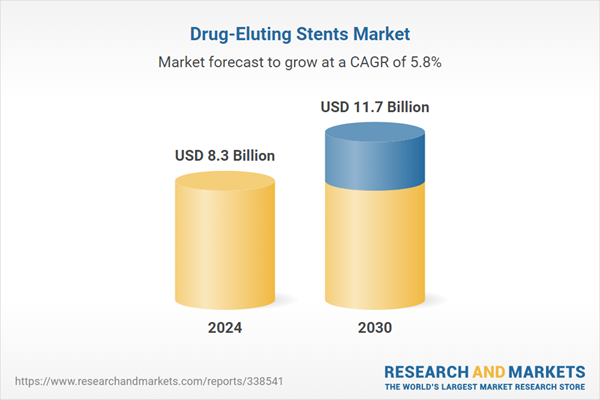The global market for Drug-Eluting Stents was valued at US$8.3 Billion in 2024 and is projected to reach US$11.7 Billion by 2030, growing at a CAGR of 5.8% from 2024 to 2030. This comprehensive report provides an in-depth analysis of market trends, drivers, and forecasts, helping you make informed business decisions. The report includes the most recent global tariff developments and how they impact the Drug-Eluting Stents market.
Segments: Coating (Polymer-Free, Polymer-based); Application (Coronary Artery Disease, Peripheral Artery Disease); End-Use (Cardiology Centers, Ambulatory Surgery Centers, Hospitals).
Geographic Regions/Countries: World; United States; Canada; Japan; China; Europe (France; Germany; Italy; United Kingdom; Spain; Russia; and Rest of Europe); Asia-Pacific (Australia; India; South Korea; and Rest of Asia-Pacific); Latin America (Argentina; Brazil; Mexico; and Rest of Latin America); Middle East (Iran; Israel; Saudi Arabia; United Arab Emirates; and Rest of Middle East); and Africa.
The analysts continuously track trade developments worldwide, drawing insights from leading global economists and over 200 industry and policy institutions, including think tanks, trade organizations, and national economic advisory bodies. This intelligence is integrated into forecasting models to provide timely, data-driven analysis of emerging risks and opportunities.
Global Drug-Eluting Stents Market - Key Trends and Drivers Summarized
What Are Drug-Eluting Stents and How Do They Function?
Drug-eluting stents (DES) are specialized medical devices used to treat coronary artery disease (CAD), a condition characterized by the narrowing of coronary arteries due to plaque buildup. These stents are tiny mesh tubes coated with medication that is gradually released to prevent the artery from becoming blocked again, a process known as restenosis. The structure of a drug-eluting stent includes a metal scaffold to provide mechanical support to the artery, and a polymer coating that controls the release of the drug over time. The drug inhibits cell proliferation and reduces inflammation, which are critical factors in preventing restenosis. By combining mechanical and pharmacological approaches, DES offer a significant improvement over bare-metal stents (BMS), which only provide structural support and are associated with higher rates of restenosis.How Have Technological Advancements Improved Drug-Eluting Stents?
The field of drug-eluting stents has seen remarkable technological advancements that have enhanced their efficacy and safety profiles. Innovations in stent design, such as thinner struts and more flexible materials, have improved the deliverability and conformability of the stents, allowing for easier navigation through complex arterial pathways. The development of biodegradable polymers, which gradually dissolve after delivering the drug, has reduced long-term complications associated with permanent polymer residues. Advances in drug formulations have also played a crucial role, with newer drugs offering better control over cell proliferation and inflammation. Imaging technologies, such as intravascular ultrasound (IVUS) and optical coherence tomography (OCT), have further refined the deployment process by providing real-time, high-resolution images of the arteries, ensuring precise placement and optimal expansion of the stents. These technological improvements collectively contribute to better patient outcomes, reducing the incidence of adverse events and the need for repeat interventions.What Are the Clinical Applications and Benefits of Drug-Eluting Stents?
Drug-eluting stents are primarily used in the treatment of coronary artery disease, but their applications extend to other vascular conditions as well. They are employed in the management of peripheral artery disease (PAD), where they help to open narrowed arteries in the legs, enhancing blood flow and reducing symptoms like pain and fatigue. The use of DES in treating complex lesions, such as those in patients with diabetes or multivessel disease, has shown promising results, offering a safer and more effective alternative to surgical interventions. The primary benefits of DES include a lower risk of restenosis and reduced need for repeat revascularization procedures, leading to improved long-term patient outcomes. Additionally, the minimally invasive nature of stent implantation, combined with shorter hospital stays and faster recovery times compared to open-heart surgery, makes DES a preferred option for many patients and healthcare providers.What Drives the Growth in the Drug-Eluting Stents Market?
The growth in the drug-eluting stents market is driven by several factors, including technological advancements, increasing prevalence of cardiovascular diseases, and expanding healthcare infrastructure. The rising incidence of coronary artery disease, partly due to lifestyle changes and an aging population, is significantly boosting the demand for effective treatment options like DES. Advances in stent technology, such as the development of next-generation stents with enhanced biocompatibility and drug delivery mechanisms, are propelling market growth. Additionally, the growing preference for minimally invasive procedures among patients and healthcare providers is driving the adoption of DES over traditional surgical methods. Regulatory approvals and favorable reimbursement policies are also playing a crucial role in expanding the market reach. Furthermore, increasing investments in research and development by key industry players and the expansion of healthcare facilities in emerging markets are creating new opportunities for growth. The integration of advanced imaging technologies with stent deployment procedures is improving clinical outcomes, further strengthening the case for DES in cardiovascular treatment protocols. These factors, combined with a greater awareness of heart health and proactive management of cardiovascular conditions, are driving the robust growth of the drug-eluting stents market.Report Scope
The report analyzes the Drug-Eluting Stents market, presented in terms of units. The analysis covers the key segments and geographic regions outlined below.Segments: Coating (Polymer-Free, Polymer-based); Application (Coronary Artery Disease, Peripheral Artery Disease); End-Use (Cardiology Centers, Ambulatory Surgery Centers, Hospitals).
Geographic Regions/Countries: World; United States; Canada; Japan; China; Europe (France; Germany; Italy; United Kingdom; Spain; Russia; and Rest of Europe); Asia-Pacific (Australia; India; South Korea; and Rest of Asia-Pacific); Latin America (Argentina; Brazil; Mexico; and Rest of Latin America); Middle East (Iran; Israel; Saudi Arabia; United Arab Emirates; and Rest of Middle East); and Africa.
Key Insights:
- Market Growth: Understand the significant growth trajectory of the Polymer-Free segment, which is expected to reach US$7.9 Billion by 2030 with a CAGR of a 6.0%. The Polymer-based segment is also set to grow at 5.2% CAGR over the analysis period.
- Regional Analysis: Gain insights into the U.S. market, valued at $2.2 Billion in 2024, and China, forecasted to grow at an impressive 9.5% CAGR to reach $2.6 Billion by 2030. Discover growth trends in other key regions, including Japan, Canada, Germany, and the Asia-Pacific.
Why You Should Buy This Report:
- Detailed Market Analysis: Access a thorough analysis of the Global Drug-Eluting Stents Market, covering all major geographic regions and market segments.
- Competitive Insights: Get an overview of the competitive landscape, including the market presence of major players across different geographies.
- Future Trends and Drivers: Understand the key trends and drivers shaping the future of the Global Drug-Eluting Stents Market.
- Actionable Insights: Benefit from actionable insights that can help you identify new revenue opportunities and make strategic business decisions.
Key Questions Answered:
- How is the Global Drug-Eluting Stents Market expected to evolve by 2030?
- What are the main drivers and restraints affecting the market?
- Which market segments will grow the most over the forecast period?
- How will market shares for different regions and segments change by 2030?
- Who are the leading players in the market, and what are their prospects?
Report Features:
- Comprehensive Market Data: Independent analysis of annual sales and market forecasts in US$ Million from 2024 to 2030.
- In-Depth Regional Analysis: Detailed insights into key markets, including the U.S., China, Japan, Canada, Europe, Asia-Pacific, Latin America, Middle East, and Africa.
- Company Profiles: Coverage of players such as Abbott Laboratories, AlviMedica, Arterius Limited, Biotronik SE, Boston Scientific Corporation and more.
- Complimentary Updates: Receive free report updates for one year to keep you informed of the latest market developments.
Some of the 33 companies featured in this Drug-Eluting Stents market report include:
- Abbott Laboratories
- AlviMedica
- Arterius Limited
- Biotronik SE
- Boston Scientific Corporation
- Cook Medical
- Medtronic plc
- STENTYS SA
- Terumo Corporation
Tariff Impact Analysis: Key Insights for 2025
Global tariff negotiations across 180+ countries are reshaping supply chains, costs, and competitiveness. This report reflects the latest developments as of April 2025 and incorporates forward-looking insights into the market outlook.The analysts continuously track trade developments worldwide, drawing insights from leading global economists and over 200 industry and policy institutions, including think tanks, trade organizations, and national economic advisory bodies. This intelligence is integrated into forecasting models to provide timely, data-driven analysis of emerging risks and opportunities.
What’s Included in This Edition:
- Tariff-adjusted market forecasts by region and segment
- Analysis of cost and supply chain implications by sourcing and trade exposure
- Strategic insights into geographic shifts
Buyers receive a free July 2025 update with:
- Finalized tariff impacts and new trade agreement effects
- Updated projections reflecting global sourcing and cost shifts
- Expanded country-specific coverage across the industry
Table of Contents
I. METHODOLOGYII. EXECUTIVE SUMMARY2. FOCUS ON SELECT PLAYERSIII. MARKET ANALYSISCANADAITALYSPAINRUSSIAREST OF EUROPESOUTH KOREAREST OF ASIA-PACIFICARGENTINABRAZILMEXICOREST OF LATIN AMERICAIRANISRAELSAUDI ARABIAUNITED ARAB EMIRATESREST OF MIDDLE EASTIV. COMPETITION
1. MARKET OVERVIEW
3. MARKET TRENDS & DRIVERS
4. GLOBAL MARKET PERSPECTIVE
UNITED STATES
JAPAN
CHINA
EUROPE
FRANCE
GERMANY
UNITED KINGDOM
ASIA-PACIFIC
AUSTRALIA
INDIA
LATIN AMERICA
MIDDLE EAST
AFRICA
Companies Mentioned (Partial List)
A selection of companies mentioned in this report includes, but is not limited to:
- Abbott Laboratories
- AlviMedica
- Arterius Limited
- Biotronik SE
- Boston Scientific Corporation
- Cook Medical
- Medtronic plc
- STENTYS SA
- Terumo Corporation
Table Information
| Report Attribute | Details |
|---|---|
| No. of Pages | 189 |
| Published | April 2025 |
| Forecast Period | 2024 - 2030 |
| Estimated Market Value ( USD | $ 8.3 Billion |
| Forecasted Market Value ( USD | $ 11.7 Billion |
| Compound Annual Growth Rate | 5.8% |
| Regions Covered | Global |









